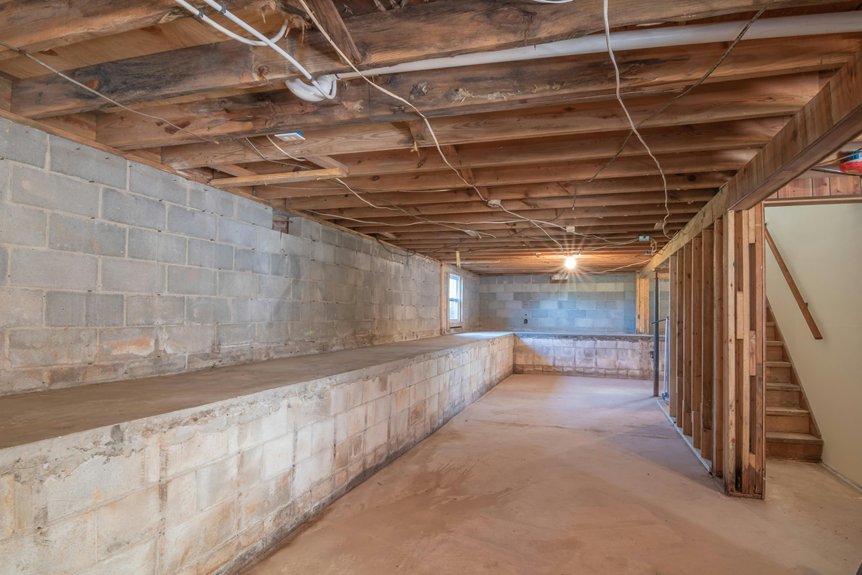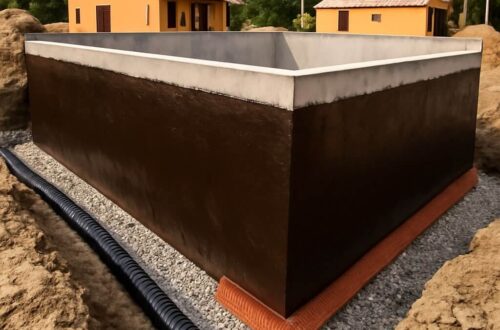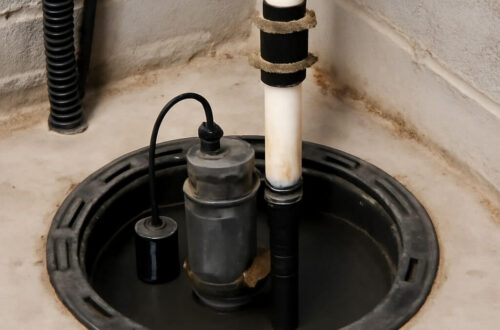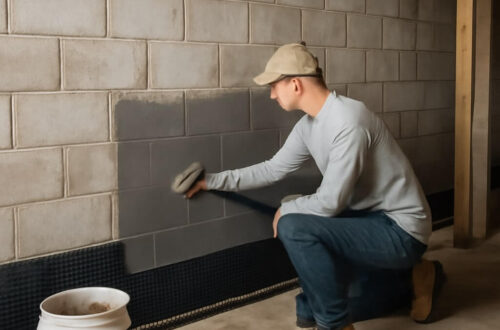Waterproofing your basement foundation is essential for preventing structural damage and mold growth. You’ll need to identify potential sources of water intrusion and prepare the space effectively. Selecting the right products is important, as is addressing any cracks or leaks promptly. Understanding these steps will set you up for success, but the process involves more than just application. Let’s explore the key techniques and considerations to guarantee your basement remains dry and secure.
Key Takeaways
- Clear the basement of clutter to facilitate a thorough inspection and waterproofing process.
- Identify and repair any cracks in walls or floors to prevent water intrusion effectively.
- Apply interior sealants and coatings evenly to fill gaps and enhance moisture resistance.
- Implement drainage solutions to redirect water away from the foundation and reduce pressure.
- Conduct regular inspections for signs of wear, moisture, or structural issues to maintain waterproofing integrity.
Understanding the Importance of Basement Waterproofing
Understanding the importance of basement waterproofing is crucial, especially if you want to protect your home from water damage. Unmanaged basement moisture can lead to structural issues, mold growth, and compromised air quality.
By implementing effective waterproofing measures, you safeguard your foundation, enhance property value, and improve living conditions. The waterproofing benefits extend beyond mere prevention; they include reduced energy costs and increased usable space.
Investing in proper techniques and materials guarantees your basement remains dry, preventing costly repairs in the future. Prioritizing waterproofing not only preserves your home’s integrity but also contributes to a healthier environment for you and your family.
Identifying Sources of Water Intrusion
Water intrusion can originate from various sources, making it imperative to identify them accurately to implement effective waterproofing solutions.
Start by examining the exterior, including gutters, downspouts, and grading around your foundation; improper drainage can elevate moisture levels.
Next, inspect for cracks in walls or floors, as these can serve as direct access points for water sources.
Additionally, consider plumbing leaks or basement appliances that may contribute to humidity.
Finally, assess the groundwater table, as high levels can exert pressure on your foundation.
Identifying these sources allows you to address them efficiently, ensuring a drier, healthier basement environment.
Preparing Your Basement for Waterproofing
Before you start waterproofing your basement, it’s essential to clear out any clutter that might obstruct the work.
This step allows you to thoroughly inspect for damage to the foundation or walls that needs addressing.
Ensuring a clean and accessible space will facilitate a more effective waterproofing process.
Clear Out Clutter
As you prepare for waterproofing your basement, clearing out clutter is essential for an effective process.
Start by organizing tools and materials you’ll need during waterproofing. Assess the current layout; remove unnecessary items to declutter space and guarantee easy access to walls and floors.
Categorize belongings into keep, donate, or discard. Utilize storage solutions like bins or shelves to maintain organization.
This not only optimizes your working area but also minimizes the risk of damage to stored items during the waterproofing process. A clean, organized basement facilitates a smoother, more efficient waterproofing effort, ultimately enhancing the project’s success.
Inspect for Damage
With the clutter cleared, your next step involves inspecting the basement for damage that could hinder the waterproofing process.
Conduct thorough foundation inspections, checking for cracks, signs of moisture, or mold growth. Focus on areas where water could enter, such as around pipes and windows.
Document any issues found during your damage assessment, as this will guide repair decisions.
Don’t overlook the importance of evaluating the floor and walls for structural concerns.
Addressing these problems before waterproofing guarantees a solid foundation, ultimately enhancing the effectiveness of your waterproofing efforts and protecting your home from future water intrusion.
Choosing the Right Waterproofing Products
Choosing the right waterproofing products is vital for guaranteeing your basement remains dry and structurally sound, especially since improper selection can lead to costly repairs down the line.
Evaluate product effectiveness by checking for certifications and reviews that indicate performance against moisture intrusion. Consider the waterproofing longevity, as products with longer-lasting protection will save you time and money in the future.
Look for options like sealants and coatings designed for your specific basement conditions, and verify they’re compatible with your foundation material. This careful selection process is essential to achieving the best results in your waterproofing efforts.
Applying Interior Sealants and Waterproof Coatings
After selecting the right waterproofing products, applying interior sealants and waterproof coatings becomes the next critical step in protecting your basement from moisture. Start by thoroughly cleaning the surfaces to guarantee maximum adhesion. Apply the interior sealants in a consistent, even manner, filling any cracks or gaps. Follow up with waterproof coatings, guaranteeing complete coverage for ideal protection.
| Step | Action | Result |
|---|---|---|
| 1 | Clean surfaces | Enhanced adhesion |
| 2 | Apply sealants | Prevents moisture entry |
| 3 | Coat walls | Long-lasting waterproofing |
Installing a Drainage System
To effectively manage water intrusion and protect your basement, installing a drainage system is essential.
Begin by evaluating your drainage design, ensuring it directs water away from your foundation. Install perforated pipes along the perimeter of your basement to collect groundwater. These pipes should lead to a sump pit, where a sump pump will remove excess water efficiently.
Choose a reliable sump pump capable of handling your basement’s volume. Regularly maintain this system to guarantee peak performance.
Ensuring Proper Ventilation
While many homeowners focus on waterproofing solutions, ensuring proper ventilation in your basement is equally essential for preventing mold and moisture buildup.
Implementing effective ventilation systems enhances air circulation, reducing humidity levels and promoting a healthier environment. Consider installing exhaust fans or air exchangers to facilitate airflow, especially in areas prone to dampness.
Additionally, maintaining open vents and ensuring unobstructed pathways for air can greatly improve ventilation efficiency. Regularly monitoring your basement’s air quality will help you identify potential issues early on, ensuring a dry, safe, and livable space.
Proper ventilation complements waterproofing efforts, creating a thorough moisture management strategy.
Addressing Cracks and Wall Leaks
To effectively address cracks and wall leaks in your basement foundation, you first need to identify the common types of cracks that can occur.
Once recognized, you can implement effective repair techniques tailored to each type, ensuring a long-lasting solution.
Additionally, establishing preventive maintenance strategies will help you mitigate future issues and protect your investment.
Identifying Common Crack Types
When evaluating your basement for potential waterproofing issues, recognizing the various types of cracks is essential for effective remediation.
Common crack types include vertical, horizontal, and stair-step cracks, each indicating specific crack causes. Vertical cracks often result from settling, while horizontal cracks typically arise from hydrostatic pressure. Stair-step cracks may indicate structural movement or shifting soil.
Understanding these distinctions helps you assess the severity of the issue and determine appropriate interventions. By identifying crack types early, you can prevent water intrusion and minimize damage, ultimately safeguarding your basement’s integrity and enhancing its waterproofing effectiveness.
Effective Repair Techniques
Addressing cracks and wall leaks effectively is essential for maintaining a dry and stable basement. Start with thorough inspection and use appropriate interior sealants for small cracks. For larger fissures, consider injecting epoxy or polyurethane foam. Additionally, do not underestimate the importance of drainage solutions.
| Repair Technique | Application |
|---|---|
| Interior Sealants | Fill minor cracks to prevent leaks |
| Epoxy Injection | Repair larger structural cracks |
| Drainage Solutions | Redirect water away from foundation |
Implementing these techniques guarantees long-term protection against moisture intrusion and enhances the overall integrity of your basement.
Preventive Maintenance Strategies
Preventive maintenance strategies are vital for preventing cracks and wall leaks in your basement. Conduct regular preventive inspections to identify potential issues before they escalate.
Look for signs of wear or deterioration in your moisture barriers, as these are essential for maintaining a dry environment. If you notice any cracks, address them immediately with appropriate sealants or repair methods.
Additionally, guarantee proper drainage around your foundation to minimize water intrusion. By proactively maintaining your basement, you can greatly reduce the risk of leaks and structural damage, guaranteeing a safe and dry space for years to come.
Regular Maintenance and Inspections
To maintain the integrity of your basement foundation, regular inspections and maintenance are essential.
Regular inspections and maintenance are crucial for preserving the integrity of your basement foundation.
Implementing routine checks and seasonal upkeep can prevent costly damage. Here’s a list to guide you:
- Inspect for cracks in walls and floors monthly.
- Check gutters and downspouts for proper drainage every season.
- Assess the exterior grading to guarantee water flows away from the foundation.
- Monitor humidity levels in the basement and use a dehumidifier if necessary.
When to Seek Professional Help
You should seek professional help if you notice signs of serious damage, such as significant cracks or water intrusion.
Additionally, if your waterproofing needs involve complex techniques or if you’re unsure about local code compliance, consulting an expert is essential.
Taking these steps guarantees that your basement foundation is properly protected and up to standard.
Signs of Serious Damage
While many homeowners may overlook minor signs of water damage, it’s crucial to recognize when these indicators escalate into serious issues that warrant professional intervention.
Pay attention to the following signs:
- Cracks in walls or floors indicating compromised structural integrity.
- Persistent dampness or musty odors suggesting elevated moisture levels.
- Warped or buckled flooring affecting the overall stability of your basement.
- Visible mold growth, which can exacerbate health issues and signal severe water intrusion.
If you notice any of these signs, don’t hesitate to consult a professional to guarantee your basement remains structurally sound and safe.
Complex Waterproofing Techniques
Recognizing the signs of serious water damage is the first step in addressing potential issues with your basement foundation.
If you encounter extensive moisture infiltration, it’s time to contemplate complex waterproofing techniques. Advanced sealing methods, such as epoxy injections or polyurethane foams, can effectively address cracks and gaps.
Additionally, implementing moisture barrier techniques, like installing vapor barriers or advanced drainage systems, is essential for long-term protection.
If these methods seem beyond your expertise or the damage is extensive, don’t hesitate to seek professional help. Experts can guarantee proper application and compliance with industry standards, safeguarding your investment effectively.
Local Code Compliance
Understanding local code compliance is essential when undertaking any waterproofing project for your basement foundation. Adhering to local building regulations guarantees safety and effectiveness.
Here’s when you should seek professional help:
- Complex Regulations: If local codes are intricate or unclear.
- Permit Requirements: When permits are mandatory for your project.
- Compliance Inspections: If your municipality requires inspections during or post-project.
- Technical Expertise: When waterproofing techniques exceed your skill level.
Involving professionals not only assures adherence to regulations but also enhances long-term reliability and performance of your waterproofing efforts.
Conclusion
By following these steps, you can effectively waterproof your basement foundation, safeguarding it against moisture and potential damage. Regular inspections and maintenance are essential to guarantee the integrity of your waterproofing efforts. Should you encounter persistent issues or extensive damage, don’t hesitate to seek professional assistance. With the right approach and products, you’ll not only protect your basement but also enhance the overall value and functionality of your home. Prioritize these tasks for long-lasting results.






